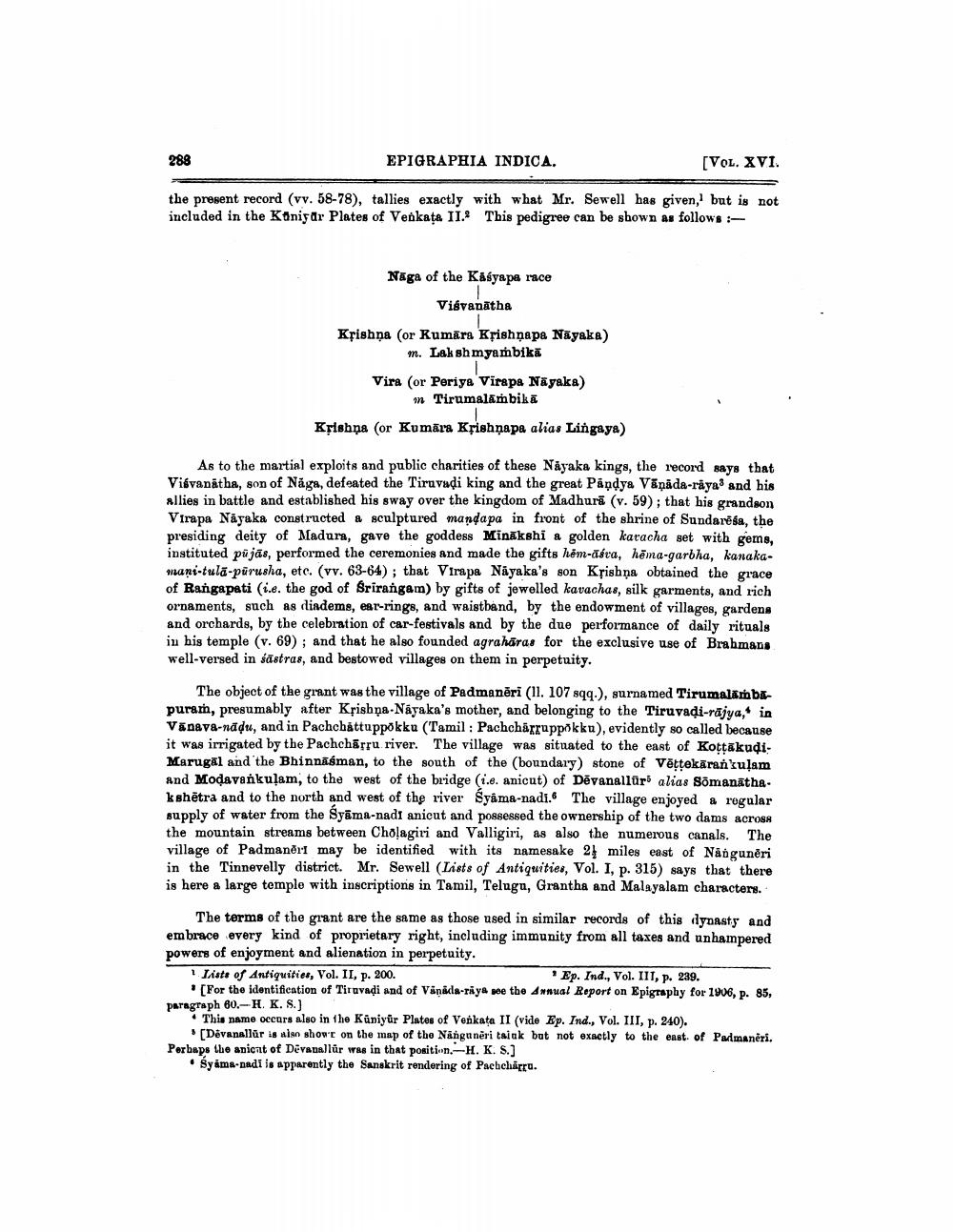________________
288
EPIGRAPHIA INDICA.
[VOL. XVI.
the present record (vv. 58-78), tallies exactly with what Mr. Sewell has given, but is not included in the Kaniyar Plates of Venkata II. This pedigree can be shown as follows:--
Naga of the Kasyapa race
I Viśvanatha
Krishna (or Kumāra Krishṇapa Nayaka) m. Lakshmyambika
Vira (or Periya Virapa Nayaka) m Tirumalambika
Krishna (or Kumara Krishnapa alias Lingaya)
As to the martial exploits and public charities of these Nayaka kings, the record says that Viśvanatha, son of Naga, defeated the Tiruvadi king and the great Pandya Vanāda-raya3 and his allies in battle and established his sway over the kingdom of Madhura (v. 59); that his grandson Virapa Nayaka constructed a sculptured mandapa in front of the shrine of Sundaresa, the presiding deity of Madura, gave the goddess Minakshi a golden kavacha set with gems, instituted pūjās, performed the ceremonies and made the gifts hem-asva, hēma-garbha, kanakamani-tula-purusha, etc. (vv. 63-64); that Virapa Nayaka's son Krishna obtained the grace of Rangapati (i.e. the god of Srirangam) by gifts of jewelled kavachas, silk garments, and rich ornaments, such as diadems, ear-rings, and waistband, by the endowment of villages, gardens and orchards, by the celebration of car-festivals and by the due performance of daily rituals in his temple (v. 69); and that he also founded agraharas for the exclusive use of Brahmans well-versed in sastras, and bestowed villages on them in perpetuity.
The object of the grant was the village of Padmanĕri (11. 107 sqq.), surnamed Tirumalambapuram, presumably after Krishna-Nayaka's mother, and belonging to the Tiruvadi-rajya, in Vanava-nadu, and in Pachchattuppökku (Tamil: Pachcharṛuppokku), evidently so called because it was irrigated by the Pachchaṛru river. The village was situated to the east of KoṭṭakudiMarugal and the Bhinnasman, to the south of the (boundary) stone of Vēṭṭekarankulam and Modavankulam, to the west of the bridge (i.e. anicut) of Devanallur alias Sōmanathakshetra and to the north and west of the river Syama-nadi. The village enjoyed a regular supply of water from the Syama-nadi anicut and possessed the ownership of the two dams across the mountain streams between Cholagiri and Valligiri, as also the numerous canals. The village of Padmaneri may be identified with its namesake 2 miles east of Nangunēri in the Tinnevelly district. Mr. Sewell (Lists of Antiquities, Vol. I, p. 315) says that there is here a large temple with inscriptions in Tamil, Telugu, Grantha and Malayalam characters.
The terms of the grant are the same as those used in similar records of this dynasty and embrace every kind of proprietary right, including immunity from all taxes and unhampered powers of enjoyment and alienation in perpetuity.
Lists of Antiquities, Vol. II, p. 200.
Ep. Ind., Vol. III, p. 239.
[For the identification of Tiruvadi and of Vanada-raya see the Annual Report on Epigraphy for 1906, p. 85, paragraph 60.-H. K. S.]
This name occurs also in the Küniyür Plates of Venkata II (vide Ep. Ind., Vol. III, p. 240).
[Devanallur is also showr on the map of the Nanguneri taiak but not exactly to the east of Padmanëri. Perhaps the anicat of Devanallur was in that position.-H. K. S.]
Syama-nadi is apparently the Sanskrit rendering of Pachchagru.




